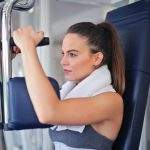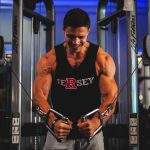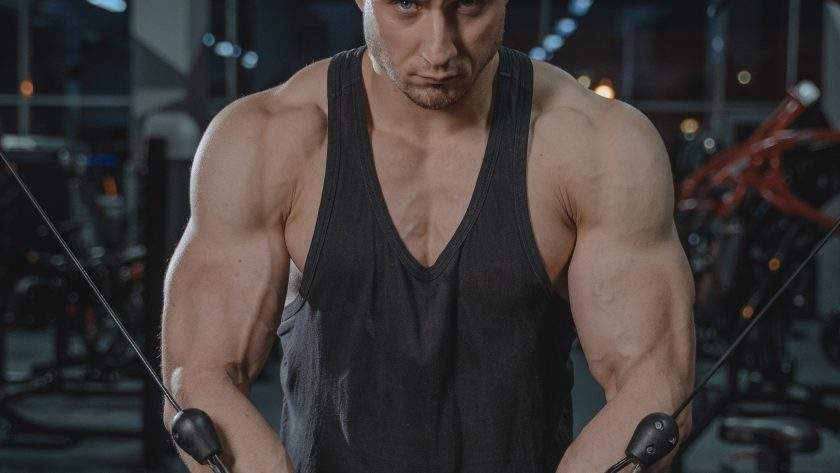Cable fly is a popular exercise that targets the chest muscles, specifically the pectoralis major. It is a strength training exercise that requires a cable machine with a pulley system and stirrup attachments. The exercise involves bringing the arms together in front of the body, simulating a fly-like motion.
The benefits of cable fly are numerous. It helps to develop a strong and defined chest, improves shoulder joint stability, and engages the core muscles. Additionally, cable fly can be performed with different variations to target different areas of the chest and to add variety to a workout routine. However, it is important to use proper form and technique to avoid injury and maximize effectiveness.
Key Takeaways
- Cable fly is a strength training exercise that targets the chest muscles.
- It helps to develop a strong and defined chest, improves shoulder joint stability, and engages the core muscles.
- Proper form and technique are important to avoid injury and maximize effectiveness.
Benefits of Cable Fly
Cable fly is a popular exercise that targets the chest muscles, specifically the pectorals major and minor. Here are some of the benefits of doing cable fly:
Firstly, cable fly provides constant tension throughout the range of motion, which is essential for muscle growth and strength gains. This is because the cable machine allows you to adjust the weight and resistance to your desired level, making it easier to maintain the tension on your chest muscles.
Secondly, cable fly allows for a greater range of motion compared to other chest exercises like bench press or dumbbell fly. This is because the cable machine allows you to move your arms in a more natural way, which can lead to greater activation of the chest muscles.
Thirdly, cable fly is a great exercise for the shoulder joint and core stability. This is because the cable machine requires you to stabilize your shoulder blades and engage your core muscles to maintain proper form throughout the exercise.
Fourthly, cable fly is a versatile exercise that can be modified to target different areas of the chest muscles. For example, doing a high-to-low cable fly can target the lower pectorals, while doing a low-to-high cable fly can target the upper pectorals.
Lastly, cable fly is a safer exercise compared to other chest exercises like bench press or dumbbell fly. This is because the cable machine provides a more controlled movement, reducing the risk of injury.
Overall, cable fly is a great exercise for anyone looking to strengthen and grow their chest muscles while maintaining proper form and minimizing the risk of injury.
Equipment Needed to Perform Cable Fly Exercises
When it comes to performing cable fly exercises, there are a few pieces of equipment that are necessary to have a successful workout. In this section, we will outline the equipment needed to perform cable fly exercises, including cable machines, handles, and benches.
Cable Machine
The most important piece of equipment needed for cable fly exercises is the cable machine. Cable machines come in various forms, including single-cable and dual-cable machines. The dual-cable machine is the most versatile and allows for a wider range of exercises to be performed. When choosing a cable machine, it is important to consider the weight stack, as heavier weight stacks will allow for more resistance during exercises.
Handles
Cable handles are another essential piece of equipment needed for cable fly exercises. Handles come in various shapes and sizes, including straight bars, curved bars, and rope handles. When choosing handles, it is important to consider comfort and grip, as well as the type of exercise being performed. For cable fly exercises, it is recommended to use handles with a neutral grip, such as rope handles.
Bench
A bench is also necessary for performing cable fly exercises. The bench should be sturdy and comfortable, with an adjustable backrest to allow for different angles during exercises. When performing cable fly exercises, it is important to keep the back flat against the bench and maintain proper form throughout the exercise.
In conclusion, to perform cable fly exercises, it is necessary to have a cable machine, handles, and a bench. When choosing equipment, it is important to consider comfort, grip, and versatility. With the right equipment, cable fly exercises can be a great addition to any workout routine.
Proper Form and Technique
Proper form and technique are crucial when performing cable flys to ensure maximum effectiveness and avoid injury. Here are some key points to keep in mind:
Positioning
Stand facing the cable machine with feet shoulder-width apart. Keep a slight bend in the knees and engage the core. Maintain a neutral spine and keep the chest up.
Grip
Grab the handles with a neutral grip (palms facing each other). Keep the elbows slightly bent and in line with the shoulders.
Motion
Slowly bring the handles together in front of the body, focusing on squeezing the chest muscles. Keep the shoulders down and back, and the scapulae (shoulder blades) retracted throughout the motion. Pause briefly at the end of the movement before slowly returning to the starting position.
It’s important to avoid any jerky or sudden movements and to maintain control throughout the exercise. To get the most out of cable flys, focus on using proper form and technique rather than the amount of weight lifted.
Remember to breathe throughout the exercise, inhaling as you bring the handles together and exhaling as you return to the starting position.
By following these guidelines, you can perform cable flys safely and effectively, leading to improved chest strength and definition.
Variations of Cable Fly
Cable fly is a great exercise for building chest muscles, but did you know that there are different variations of this exercise that you can try? In this section, we will discuss three variations of cable fly that can help you target your chest muscles from different angles and achieve better results.
Standing Cable Fly
The standing cable fly is a variation of cable fly that is performed while standing up. This variation is great for targeting the upper chest muscles and improving your posture. To perform this exercise, you will need a cable machine and two handles. Here’s how to do it:
- Stand facing the cable machine with your feet shoulder-width apart.
- Hold the handles with your palms facing each other and your arms extended in front of you.
- Slowly bring your arms out to the sides, keeping your elbows slightly bent.
- Pause for a second, then slowly bring your arms back to the starting position.
Low Cable Fly
The low cable fly is a variation of cable fly that is performed while lying on your back. This variation is great for targeting the lower chest muscles and improving your overall chest development. To perform this exercise, you will need a cable machine and a bench. Here’s how to do it:
- Lie on your back on the bench with your feet flat on the floor.
- Hold the handles with your palms facing each other and your arms extended above your chest.
- Slowly bring your arms down to the sides, keeping your elbows slightly bent.
- Pause for a second, then slowly bring your arms back to the starting position.
Incline Cable Fly
The incline cable fly is a variation of cable fly that is performed while lying on an incline bench. This variation is great for targeting the upper chest muscles and improving your overall chest development. To perform this exercise, you will need a cable machine and an incline bench. Here’s how to do it:
- Lie on the incline bench with your feet flat on the floor.
- Hold the handles with your palms facing each other and your arms extended above your chest.
- Slowly bring your arms down to the sides, keeping your elbows slightly bent.
- Pause for a second, then slowly bring your arms back to the starting position.
In conclusion, cable fly is a great exercise for building chest muscles, and these variations can help you target your chest muscles from different angles. By incorporating these variations into your workout routine, you can achieve better results and improve your overall chest development.
Common Mistakes and How to Avoid Them
When performing cable flys, it is important to use proper form and technique to avoid injury and maximize the effectiveness of the exercise. However, there are some common mistakes that people make when performing this exercise. Here are some of the most common mistakes and how to avoid them:
Using Too Much Weight
One of the biggest mistakes people make when performing cable flys is using too much weight. This can put unnecessary pressure on the joints and increase the risk of injury. To avoid this, start with a lighter weight and focus on proper form and technique. Gradually increase the weight as you become more comfortable with the exercise.
Poor Form and Technique
Another common mistake is poor form and technique. This can lead to ineffective workouts and increase the risk of injury. To avoid this, make sure to keep your elbows slightly bent, your back straight, and your feet firmly planted on the ground. Use slow, controlled movements and focus on squeezing your chest muscles at the top of the movement.
Neglecting the Negative
Many people neglect the negative portion of the exercise, which is when you lower the weight back down. This can lead to an imbalance in muscle development and limit the effectiveness of the exercise. To avoid this, focus on controlling the weight on the way down and squeezing your chest muscles throughout the entire movement.
One Rep Max
Some people try to perform cable flys with their one rep max, which is the maximum amount of weight they can lift for one repetition. This can put excessive strain on the muscles and increase the risk of injury. To avoid this, use a weight that allows you to perform the exercise with proper form and technique.
In conclusion, cable flys are a great exercise for building chest strength and size. However, it is important to use proper form and technique to avoid injury and maximize the effectiveness of the exercise. By avoiding these common mistakes, you can get the most out of your cable fly workouts and achieve your fitness goals.
Workout Plans
Beginner Cable Fly
If you are new to cable fly workouts, start with a low weight and focus on proper form. Aim for 3 sets of 10 reps with a minute of rest between sets. Gradually increase the weight as you progress. It’s important to not push yourself too hard too fast, as this can lead to injury.
Intermediate Cable Fly
For those who have some experience with cable fly workouts, aim for 3-4 sets of 12-15 reps with 45 seconds of rest between sets. Increase the weight as needed to maintain proper form and intensity. It’s important to challenge yourself, but also listen to your body and avoid overexertion.
Advanced Cable Fly
If you are an experienced cable fly enthusiast, aim for 4-5 sets of 15-20 reps with 30 seconds of rest between sets. Use a weight that challenges you, but still allows you to maintain proper form. To further increase intensity, consider incorporating drop sets or supersets into your routine.
Regardless of your experience level, it’s important to vary your chest workouts to avoid plateauing. Incorporating cable fly workouts into your routine can help target different areas of the chest and provide a new challenge. Remember to always warm up properly and cool down after your workout to prevent injury and aid in recovery.
In conclusion, cable fly workouts can be a valuable addition to any chest workout routine. By following proper form and gradually increasing intensity, you can see progress and build strength in your chest muscles. Don’t be afraid to challenge yourself, but always listen to your body and avoid overexertion.
Tips for Maximizing Effectiveness
To get the most out of cable fly exercises, there are a few key tips to keep in mind. These tips can help you target the right muscles, achieve peak contraction, and maximize muscle gain.
First, it’s important to pay attention to your form. Keep your core engaged and your back straight throughout the exercise. This will help you stabilize your body and avoid injury. Additionally, make sure that you’re using the right weight for your fitness level. If the weight is too heavy, you may not be able to achieve proper form and target the right muscles.
Another tip for maximizing effectiveness is to focus on the lower pectoral muscles. Cable fly exercises are particularly effective at targeting these muscles, which can help you achieve greater size and definition in your chest. To target the lower pecs, try adjusting the height of the cables to a lower position.
To achieve peak contraction during cable fly exercises, focus on squeezing your chest muscles at the top of the movement. This will help you engage the muscle fibers and get the most out of each rep. Additionally, you can try drop sets or other intensity techniques to push your muscles to the limit and maximize muscle gain.
Finally, it’s important to remember that cable fly exercises are just one part of a comprehensive chest workout. To achieve balanced chest development, it’s important to incorporate a variety of exercises that target different muscle groups and stabilizing muscles. By combining cable fly exercises with other chest exercises, you can achieve a well-rounded chest workout and see maximum results.
Frequently Asked Questions
What muscle do cable flyes work?
Cable flyes mainly work the chest muscles, particularly the pectoralis major and minor. However, they also engage the triceps and shoulders to a lesser extent. Cable flyes are a great exercise to isolate and target the chest muscles.
Is cable fly good for chest?
Yes, cable flyes are an effective exercise for building and strengthening the chest muscles. It allows for a greater range of motion and provides constant tension throughout the movement, making it a great exercise for muscle activation and growth.
How to do a proper cable fly?
To perform proper cable flyes, stand in the center of a cable machine with the pulleys set to the highest position. Grab the handles with an overhand grip and step forward with one foot. Keeping your arms slightly bent, bring the handles down and in front of your body until they meet at the center of your chest. Slowly return to the starting position and repeat for the desired number of reps.
What height should cable chest fly be?
The height of the cable machine for cable chest flyes should be set to the highest position. This allows for a greater range of motion and targets the upper chest muscles more effectively.
What is the difference between cable fly and dumbbell fly?
The main difference between cable flyes and dumbbell flyes is the resistance. Cable flyes provide constant tension throughout the movement, while dumbbell flyes rely on gravity and momentum. Cable flyes also allow for a greater range of motion and can be adjusted to target different areas of the chest.
What are the benefits of cable flyes?
Cable flyes provide several benefits, including increased chest muscle activation, improved muscle balance and symmetry, greater range of motion, and increased muscle growth and strength. They are also a versatile exercise that can be adjusted to target different areas of the chest and can be easily incorporated into any workout routine.
Other Posts You May Enjoy!
- Lat Pullover: A Complete Guide to Building a Strong Back

- The Benefits and Proper Usage of a Chest Fly Machine | The Ultimate Guide

- Incline Dumbbell Fly: How to Properly Execute for Maximum Chest Development

- Cable Chest Workout: Exercises and Tips for Maximum Results

- Chest Workout at Home: The Ultimate Guide to Strengthening and Defining Your Pecs

EXPAND YOUR MIND
Join the best newsletter that you never knew you needed. You’ll get emails containing grooming tips, new blog posts, product launches, giveaways, and motivation to help you Keep on Keeping on.

